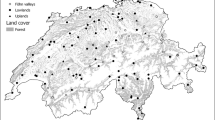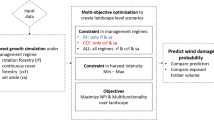Abstract
• Context
Among natural disturbances, wind storms cause the greatest damage to forests in Austria.
• Aim
The aim of this study is to quantify the effects of site, stand and meteorological attributes on the wind disturbance regime at the operational scale of forest stands.
• Methods
We used binomial generalized linear mixed models (GLMMs) to quantify the probability of damage events and linear mixed models (LMMs) to explain the damage intensity at the forest stand level in four management units with a total forest area of approximately 28,800 ha.
• Results
Timber stock volume, stand age, elevation, previous disturbances, wind gust speed and frozen state of soil contributed in explaining probability of wind damage. While the model of disturbance probability correctly classified 90 % of all cases in the data set (specificity 95 %, sensitivity 26 %), the model for damage intensity explained only low percentages of the variation in the observed damage data (full model R 2 = 0.38, fixed effects-only model R 2 = 0.09; cross-validation in the four forest management units yielded similar R 2 values).
• Conclusion
The developed models indicated that decreasing the proportion of Norway spruce (Picea abies [L.] Karst), limiting stand age and reducing the timber stock in course of tending treatments in stands exposed to wind disturbance can mitigate the risk and the expected damage intensity. High gust speeds and salvage cuts after earlier damage increase the probability of further wind disturbance events.






Similar content being viewed by others
References
Akaike H (1973) Information theory and an extension of the maximum likelihood principle. In: Petrov BN, Csaki F (eds) Second international symposium on information theory. Akadémiai Kiadó, Budapest, pp 267–281
Anonymous (2013) Holzeinschlag 2012. BMLFUW, Abteilung IV/1. Wien
Arnold TW (2010) Uninformative parameters and model selection using Akaike’s information criterion. J Wildl Manag 74:1175–1178. doi:10.2193/2009-367
Baayen RH (2011) Language R: Data sets and functions with “Analyzing Linguistic Data: a practical introduction to statistics”. R package version 1.4
Barton K (2013) MuMIn: multi-model inference. R package version 1.9.0
Bates D, Maechler M, Bolker B (2012) lme4: Linear mixed-effects models using S4 classes. R package version 0.999999-0
Bolker BM, Brooks ME, Clark CJ, Geange SW, Poulsen JR, Stevens MHM, White J-SS (2009) Generalized linear mixed models: a practical guide for ecology and evolution. Trends Ecol Evol 24:127–135. doi:10.1016/j.tree.2008.10.008
Brang P, Schönenberger W, Frehner M, Schwitter R, Thormann J-J, Wasser B (2006) Management of protection forests in the European Alps: an overview. For Snow Landsc Res 80:23–44
Burnham KP, Anderson DR (2002) Model selection and multimodel inference. Springer, New York
Crawley MJ (2002) Statistical computing: an introduction to data analysis using S-PLUS. Wiley, New York
Cvitan L (2003) Determining wind gusts using mean hourly wind speed. Geofizika 20:63–74
Dale VH, Joyce LA, McNulty S, Neilson RP (2000) The interplay between climate change, forests, and disturbances. Sci Total Environ 262:201–204. doi:10.1016/S0048-9697(00)00522-2
Dobbertin M (2002) Influence of stand structure and site factors on wind damage comparing the storms Vivian and Lothar. For Snow Landsc Res 77:187–205
ESRI (2012) ArcGIS desktop: Release 10. Environmental Systems Research Institute, Redlands
Fawcett T (2006) An introduction to ROC analysis. Pattern Recogn Lett 27:861–874. doi:10.1016/j.patrec.2005.10.010
Gardiner B, Peltola H, Kellomäki S (2000) Comparison of two models for predicting the critical wind speeds required to damage coniferous trees. Ecol Model 129:1–23. doi:10.1016/S0304-3800(00)00220-9
Gardiner B, Blennow K, Carnus JM, Fleischner P, Ingemarson F, Landmann G, Lindner M, Marzano M, Nicoll B, Orazio C, Peyron JL, Reviron MP, Schelhaas M, Schuck A, Spielmann M, Usbeck T (2010) Destructive storms in European forests: past and forthcoming impacts. Final report to European Commission - DG Environment. EFIATLANTIC, European Forest Institute
Haiden T, Kann A, Wittmann C, Pistotnik G, Bica B, Gruber C (2011) The Integrated Nowcasting through Comprehensive Analysis (INCA) system and its validation over the Eastern Alpine Region. Weather Forecast 26:166–183. doi:10.1175/2010WAF2222451.1
Hanewinkel M, Breidenbach J, Neeff T, Kublin E (2008) Seventy-seven years of natural disturbances in a mountain forest area—the influence of storm, snow, and insect damage analysed with a long-term time series. Can J For Res 38:2249–2261. doi:10.1139/X08-070
Hanewinkel M, Albrecht A, Schmidt M (2013) Influence of stand characteristics and landscape structure on wind damage. In: Gardiner B, Schuck A, Schelhaas M-J, Orazio C, Blennow K, Nicoll B (eds) What science can tell us—living with storm damage to forests. European Forest Institute, pp 39–45
Harrell FE (2012) Hmisc: Harrell miscellaneous. R package version 3.9-3
Hosmer DW, Lemeshow S, Sturdivant RX (2013) Applied logistic regression, 3rd edn. Wiley, New York
Jalkanen A, Mattila U (2000) Logistic regression models for wind and snow damage in northern Finland based on the National Forest Inventory data. For Ecol Manage 135:315–330. doi:10.1016/S0378-1127(00)00289-9
Jönsson AM, Bärring L (2011) Future climate impact on spruce bark beetle life cycle in relation to uncertainties in regional climate model data ensembles. Tellus A 63:158–173. doi:10.1111/j.1600-0870.2010.00479.x
Klaus M, Holsten A, Hostert P, Kropp JP (2011) Integrated methodology to assess windthrow impacts on forest stands under climate change. For Ecol Manage 261:1799–1810. doi:10.1016/j.foreco.2011.02.002
Klopcic M, Poljanec A, Gartner A, Boncina A (2009) Factors related to natural disturbances in mountain Norway spruce (Picea abies) forests in the Julian Alps. Ecoscience 16:48–57. doi:10.2980/16-1-3181
Lanquaye-Opoku N, Mitchell SJ (2005) Portability of stand-level empirical windthrow risk models. For Ecol Manage 216:134–148. doi:10.1016/j.foreco.2005.05.032
Lindner M, Rummukainen M (2013) Climate change and storm damage risk in European forests. In: Gardiner B, Schuck A, Schelhaas M-J, Orazio C, Blennow K, Nicoll B (eds) What science can tell us—living with storm damage to forests. European Forest Institute, pp 109–115
Lindner M, Maroschek M, Netherer S, Kremer A, Barbati A, Garcia-Gonzalo J, Seidl R, Delzon S, Corona P, Kolström M, Lexer MJ, Marchetti M (2010) Climate change impacts, adaptive capacity, and vulnerability of European forest ecosystems. For Ecol Manage 259:698–709. doi:10.1016/j.foreco.2009.09.023
Marini L, Lindelöw Å, Jönsson AM, Wulff S, Schroeder LM (2013) Population dynamics of the spruce bark beetle: a long-term study. Oikos. doi:10.1111/j.1600-0706.2013.00431.x
Marschall J (1975) Hilfstafeln für die Forsteinrichtung. Österreichischer Agrarverlag, Wien
Mayer H (1987) Wind-induced tree sway. Trees 1:95–106. doi:10.1007/BF01816816
Mitchell SJ, Hailemariam T, Kulis Y (2001) Empirical modeling of cutblock edge windthrow risk on Vancouver Island, Canada, using stand level information. For Ecol Manage 154:117–130. doi:10.1016/S0378-1127(00)00620-4
Mosteller F, Tukey JW (1968) Data analysis, including statistics. In: Lindzey G, Aronson E (eds) Handbook of social psychology, vol. 2. Addison-Wesley, Reading, pp 80–203
Nagel TA, Diaci J (2006) Intermediate wind disturbance in an old-growth beech–fir forest in southeastern Slovenia. Can J For Res 36:629–638. doi:10.1139/X05-263
Nicoll BC, Gardiner BA, Rayner B, Peace AJ (2006) Anchorage of coniferous trees in relation to species, soil type and rooting depth. Can J For Res 36:1871–1883. doi:10.1139/X06-072
Nicoll BC, Gardiner BA, Peace AJ (2008) Improvements in anchorage provided by the acclimation of forest trees to wind stress. Forestry 81:389–398. doi:10.1093/forestry/cpn021
Nilsson C, Goyette S, Bärring L (2007) Relating forest damage data to the wind field from high-resolution RCM simulations: case study of anatol striking Sweden in December 1999. Global Planet Change 57:161–176. doi:10.1016/j.gloplacha.2006.11.011
Olofsson E, Blennow K (2005) Decision support for identifying spruce forest stand edges with high probability of wind damage. For Ecol Manage 207:87–98. doi:10.1016/j.foreco.2004.10.019
Overbeck M, Schmidt M (2012) Modelling infestation risk of Norway spruce by Ips typographus (L.) in the Lower Saxon Harz Mountains (Germany). For Ecol Manage 266:115–125. doi:10.1016/j.foreco.2011.11.011
Paul IK, Polglase PJ, Smethurst PJ, O’Connell AM, Carlyle CJ, Khanna PK (2004) Soil temperature under forests: a simple model for predicting soil temperature under a range of forest types. Agr Forest Meteorol 121:167–182. doi:10.1016/j.agrformet.2003.08.030
Peltola H, Kellomäki S, Vaisanen H, Ikonen V-P (1999) A mechanistic model for assessing the risk of wind and snow damage to single trees and stands of Scots pine, Norway spruce and birch. Can J For Res 29:647–661. doi:10.1139/x99-029
Pinheiro J, Bates D (2000) Mixed-effects models in S and S-PLUS. Springer, New York
Prem J, Beer R (2012) Datensammlung 2012 zum Österreichischen Waldbericht. BMLFUW, Abteilung IV/1. Wien
Pretzsch H (2010) Forest dynamics, growth and yield. Springer, Berlin
Quine CP, White IMS (1998) The potential of distance-limited topex in the prediction of site windiness. Forestry 71:325–332. doi:10.1093/forestry/71.4.325
R Core Team (2013) R: A language and environment for statistical computing. R Foundation for Statistical Computing, Vienna
Rochelle JA, Lehmann LA, Wisniewski J (1999) Forest fragmentation: wildlife and management implications. Brill Academic Publishers, Leiden
Schelhaas M-J, Nabuurs G-J, Schuck A (2003) Natural disturbances in the European forests in the 19th and 20th centuries. Glob Change Biol 9:1620–1633. doi:10.1046/j.1365-2486.2003.00684.x
Schindler D, Grebhan K, Albrecht A, Schönborn J (2009) Modelling the wind damage probability in forests in Southwestern Germany for the 1999 winter storm ‘Lothar’. Int J Biometeorol 53:543–554. doi:10.1007/s00484-009-0242-3
Schindler D, Grebhan K, Albrecht A, Schönborn J, Kohnle U (2012) GIS-based estimation of the winter storm damage probability in forests: a case study from Baden-Wuerttemberg (Southwest Germany). Int J Biometeorol 56:57–69. doi:10.1007/s00484-010-0397-y
Schmidt M, Hanewinkel M, Kändler G, Kublin E, Kohnle U (2010) An inventory-based approach for modelling single-tree storm damage—experiences with the winter storm of 1999 in southwestern Germany. Can J For Res 40:1636–1652. doi:10.1139/X10-099
Schütz J-P, Götz M, Schmid W, Mandallaz D (2006) Vulnerability of spruce (Picea abies) and beech (Fagus sylvatica) forest stands to storms and consequences for silviculture. Eur J Forest Res 125:291–302. doi:10.1007/s10342-006-0111-0
Sellier D, Fourcaud T (2009) Crown structure and wood properties: influence on tree sway and response to high winds. Am J Bot 96:885–896. doi:10.3732/ajb.0800226
Stocker TF, Qin D, Plattner G-K, Tignor MMB, Allen SK, Boschung J, Nauels A, Xia Y, Bex V, Midgley PM (eds) Climate change 2013: the physical science basis. Contribution of Working Group I to the fifth assessment report of the intergovernmental panel on climate change. Cambridge University Press, Cambridge, United Kingdom and New York
Thom D, Seidl R, Steyrer G, Krehan H, Formayer H (2013) Slow and fast drivers of the natural disturbance regime in Central European forest ecosystems. For Ecol Manage 307:293–302. doi:10.1016/j.foreco.2013.07.017
Thürig E, Palosuo T, Bucher J, Kaufmann E (2005) The impact of windthrow on carbon sequestration in Switzerland: a model-based assessment. For Ecol Manage 210:337–350. doi:10.1016/j.foreco.2005.02.030
Usbeck T, Waldner P, Dobbertin M, Ginzler C, Hoffmann C, Sutter F, Steinmeier C, Volz R, Schneiter G, Rebetez M (2012) Relating remotely sensed forest damage data to wind data: storms Lothar (1999) and Vivian (1990) in Switzerland. Theor Appl Climatol 108:451–462. doi:10.1007/s00704-011-0526-5
Valinger E, Fridman J (1999) Models to assess the risk of snow and wind damage in pine, spruce, and birch forests in Sweden. Environ Manage 24:209–217. doi:10.1007/s002679900227
Weinfurter P (2004) Waldbauhandbuch. Eine Orientierungshilfe für die Praxis. Österreichsiche Bundesforste AG
Weis W, Rotter V, Göttlein A (2006) Water and element fluxes during the regeneration of Norway spruce with European beech: effects of shelterwood-cut and clear-cut. For Ecol Manage 224:304–317. doi:10.1016/j.foreco.2005.12.040
Xi W, Peet RK (2011) The complexity of catastrophic wind impacts on temperate forests. In: Lupo A (ed) Recent hurricane research—climate, dynamics and societal impacts. Vienna, pp 503–534
Zuur A, Ieno EN, Walker N, Saveliev AA, Smith GM (2008) Mixed effects models and extensions in ecology with R. Springer, New York
Acknowledgments
We are indebted to the Austrian Federal Forests for making internal data available. Two anonymous referees provided detailed and helpful comments on an earlier version of the manuscript.
Funding
This study was funded by the Austrian Climate Research Program (ACRP), under grant no. K09AC0K00042.
Author information
Authors and Affiliations
Corresponding author
Additional information
Handling Editor: Thomas Wohlgemuth
Contribution of the co-authors
Ferenc PASZTOR: designing the experiment, database reconstruction, running the data analysis and writing the paper
Christoph MATULLA: providing data and writing the paper
Maja ZUVELA-ALOISE: providing data and writing the paper
Werner RAMMER: database reconstruction and writing the paper
Manfred J LEXER: designing the experiment, supervising the work, coordinating the research project and writing the paper
Rights and permissions
About this article
Cite this article
Pasztor, F., Matulla, C., Zuvela-Aloise, M. et al. Developing predictive models of wind damage in Austrian forests. Annals of Forest Science 72, 289–301 (2015). https://doi.org/10.1007/s13595-014-0386-0
Received:
Accepted:
Published:
Issue Date:
DOI: https://doi.org/10.1007/s13595-014-0386-0




